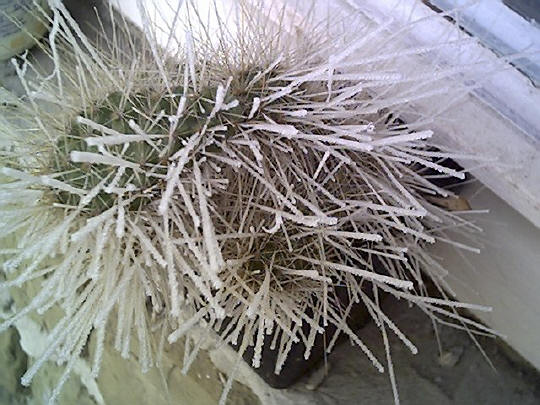Hoar frost is
dew turned to
frost and refers to the
ice
crystals generally assuming
the forms of scales, needles, feathers or fans
deposited on
plants or exposed objects,
that form when the air is
moist (saturated)
and touches a very cold
surface and
freezes on it instantly.
Hoar frost is often seen on cold, clear
autumn nights. Hoar
frost can occur at higher
temperatures than rime
frost – usually when the air temperature is around 0°
C. However, the
ground or exposed surfaces
are usually much colder.
|
Dew
and hoarfrost accumulate on objects during clear, chilly
nights only when there is
more humidity in the
air than the air can carry. Grass,
twigs and other surfaces are
strongly cooled with a net loss of
heat driven by strong, uninterrupted outward
radiation. (If there were
clouds present, or
fog were to form, then these
would absorb,
then "re"-radiate
heat back to the surface,
slowing or cancelling the fall of temperature. A breeze would
also stir the lower
atmosphere, mixing warmer air above the surface with that on
the surface - this too would offset surface heat loss.)
Provided that this 'loss' of heat is not made up from elsewhere
(e.g. upward flux from the soil, emission of heat from adjacent
buildings etc.), the temperature of such objects will fall below
that of the adjacent air. As soon as the surface is cooled below
the saturation
temperature (dew point),
water vapour will begin to
condense onto these
surfaces (either vapour from moist soil surfaces diffusing
upwards to the chilled object, or downward mixing of vapour from
the over-lying atmosphere): if the air temperature remains above
0° C, this water will remain liquid as drops of dew. |
| Once hoar-frost
crystals form, they can remain as long as conditions for their
existence are favourable. Hence in late
winter we see the
sun's warming rays
removing hoar-frost from the south sides of objects. Hoar frost
is white because the crystals contain air. The formation of
frost is an example of
meteorological
deposition. The opposite of deposition. is
sublimation. |
|

Hoar frost on Opuntia hystricina
(Photo courteously provided by
Pal Vajda - Hungary) |
|